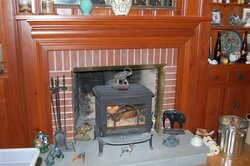So after my install in front of my existing fireplace, I'll only have 25.5" between the stove top and the underside of the wood mantel. I believe Jotul calls for 32" for the F3CB.
Soooo.......I'm going to fabricate a nice sheet metal shield to hang underneath the mantel during burning season. My question is, do you think 1" of dead air space between the wood and the metal will be sufficient or should I make it 2" or more. I plan on having it angle in a couple of places to move the heat out and in front of the mantle, but wonder about the heat transfer. That's obviously gonna be one of the hottest areas.
___________
___________I This is a rough side view. Mantle with sheet metal "floating" underneath
____________/
/
Thoughts?
Soooo.......I'm going to fabricate a nice sheet metal shield to hang underneath the mantel during burning season. My question is, do you think 1" of dead air space between the wood and the metal will be sufficient or should I make it 2" or more. I plan on having it angle in a couple of places to move the heat out and in front of the mantle, but wonder about the heat transfer. That's obviously gonna be one of the hottest areas.
___________
___________I This is a rough side view. Mantle with sheet metal "floating" underneath
____________/
/
Thoughts?


 Thanks for posting that link. I haven't seen one before, and am glad to know that I was on the right track.
Thanks for posting that link. I haven't seen one before, and am glad to know that I was on the right track. 